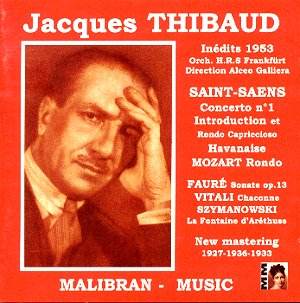There is precious little live Thibaud so it’s a matter
for rejoicing when some turns up. We have the three Enescu-conducted
Mozart Concertos from 1951 – live Paris broadcasts – and in recent years
the Ansermet Lalo Symphonie Espagnole from 1941 has surfaced
(and is available on APR). This Malibran issue has uncovered the fruit
of a two-day concert schedule given by the seventy-three year old in
Frankfurt. From his orchestral concert we have the First Concerto of
Saint-Saëns and the Introduction and Rondo Capriccioso and from
the following day’s recital with pianist Marinus Flipse we have a Mozart
Sonata rondo (only) and the Havanaise. The rest of the material here
– bar the delightful radio interview – derives from commercial recordings
ranging from 1927 to 1936.
We are especially fortunate to have the Saint-Saëns
Concerto because, though closely associated with his music, Thibaud
left no commercial recordings of any of the Concertos. Recorded a trifle
boxily but in excellent fidelity the tapes from the orchestra’s archive
have survived in splendid shape. It would be idle to pretend that this
is the Thibaud of old. Recorded a few scant months before his death
in an air crash he is very much in decline and those seeking the sensuous
tone and the exotically spiced portamenti of the young Thibaud will
search in vain because, like many another violinist (and especially
those who famously are less than scrupulous about practising) his glory
days were over two decades back. The tone is a shadow of its former
self, intonation wanders and whilst the portamenti are still quite athletic
and evocative his luxurious, once-in-a-lifetime vibrato has slackened
alarmingly. His trills are reasonable but not of electric speed and
not quite climactic enough. What remains is a sovereign sense of phrasing,
his sensitivity in the slow central panel of the short thirteen-minute
work, and the romantic nuance he can still manage to impart despite
the lack of tonal projection. In the final section his bowing is still
reasonably well sustained with more quick slides and some rather starved
notes. In conception he is affectionate and triumphant but one has to
take the execution and think back to the gorgeous liquidity of the 1910s
and 1920s to imagine quite what he could do with this repertoire. In
that sense this is not unlike the later Elman Vanguards – the vestiges
of a great player who, albeit quite imperfectly, has something still
to teach.
In the Introduction and Rondo Capriccioso his lower
strings are very much less responsive, the trills slower but there are
still plenty of suave finger position changes and a surety of conception.
Turning back to his commercial recordings of the piece – with Armour
for Pathé and, in the orchestral version, with the Orchestre
Symphonique de Paris under Ruhlmann again for Pathé in 1914 –
and we find that his vibrancy and tonal allure have long since dissipated
by the early 50s. Similarly the Havanaise, which here is slightly quicker
than his 1933 traversal with Janopoulo and the c.1914 disc with Armour.
The Mozart Rondo derives from the Sonata in B flat which he recorded
complete with Marguerite Long for HMV in 1943, one of his less well-known
wartime recordings. The acoustic here is rather dead and the performance
though attractive is inferior to the Long – but it’s a precious souvenir
of Thibaud in one of the things he did better than almost any other
musician of his generation – play Mozart.
The remainder will be well loved by all who revere
Thibaud. The Vitali is full of luscious romanticism, sumptuous portamenti,
and ravishing tone – even if he does excise the more difficult thirds
and octaves passage towards the end. The Fauré Sonata is high
on lyrical effulgence and drive, saturated in the ethos that other more
obviously high octane performance ignore at their peril. Cortot’s animation
of the left hand in the Allegro opening is still marvelous as is the
exquisite rise and fall of the line in the Andante. The elfin litheness
and pert athleticism of both men in the Scherzo is joyful and there’s
panache a-plenty in the finale. He is surely as convincing in Szymanowski
as Kochanski must have been (speculation of course, no evidence of Kochanski’s
Szymanowski has survived). His La Fontaine d’Aréthuse is full
of luscious liquidity and exoticism, Thibaud’s explicit sensuality finding
a just and succulent text in the first of the Myths. In the interview
he speaks wittily about his early experiences, about seeing Paul Verlaine,
Chausson and Saint-Saëns and about his famous fiddle.
The notes are extensive and affectionate and the photographs
in the most attractive booklet are delightful and of marvellous quality.
For a Thibaud devotee it is a particular pleasure to see him in portrait,
pensive and humorous, or photographed having his left hand set in a
plaster cast by a sculptor – he observes the process with quizzical
curiosity. Even his most vociferous admirers could hardly claim that
the recently unearthed 1953 material finds Thibaud in other than decline,
as I said, but it makes for a curiously affecting symmetry to play these
survivors alongside the glorious tonalist of the teens and twenties.
For all the deficiencies and limitations I wouldn’t want to be without
this disc.
Jonathan Woolf

